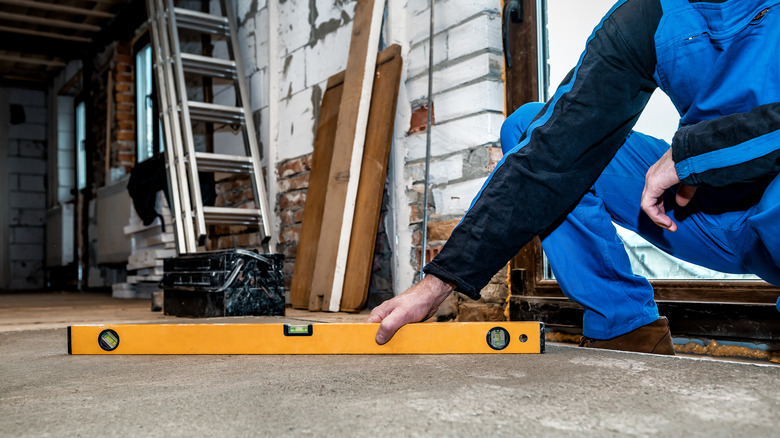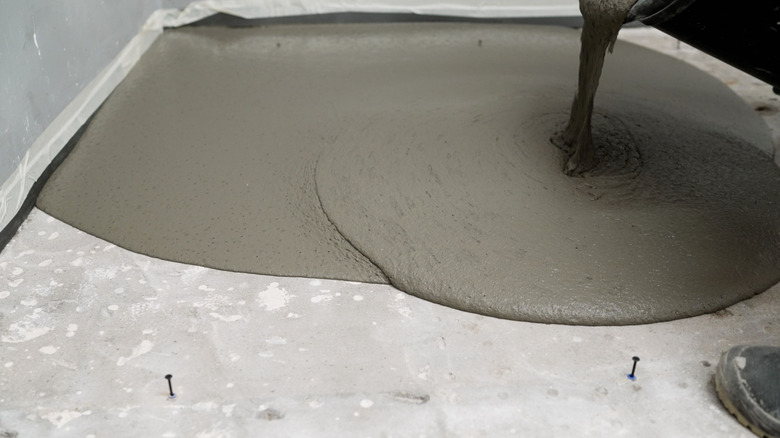The One Thing Mike Holmes Says To Never Overlook Before Installing New Flooring
We may receive a commission on purchases made from links.
Mike Holmes, host of HGTV's "Holmes Family Rescue," has made a career out of fixing renovation mistakes. Through current and past shows, including "Holmes on Homes," Holmes Makes it Right," and "Holmes Inspection," he has seen every type of DIY disaster and professional contractor screw-up. On his programs, he not only corrects construction disasters but offers homeowners advice on how to avoid them in the first place. And when you're looking for issues to address, Holmes says you can start from the ground up.
"Throughout my career, I have seen some really crappy tiling jobs and it's usually because the contractor didn't level the floor," Holmes wrote for his Make It Right blog. "When it comes to flooring what the finish looks like is largely a result of what's underneath it." You can't turn a sow's ear into a silk purse, and an uneven floor is a big sow's ear. If you lay any of the best flooring options for your home (such as vinyl, tile, or hardwood) on an uneven floor, it will have unsightly bumps that can be a major tripping hazard, especially for those with mobility issues. Your flooring will also wear out much more quickly by buckling or pulling up in spots. It's pointless to spend the time and money on a spanking new floor if it will eventually have to be demoed and relaid to fix the problem underneath.
Mike Holmes' tips for telling if you have an uneven floor
Sometimes, you can tell right away if your floors are uneven. Other indicators are a little more subtle. According to Mike Holmes via his Make It Right blog, squeaking or bouncy floors and cracking tiles and grout could be signs of an uneven floor. You can check for uneven flooring with a level or by dropping marbles on the floor and seeing where they congregate. Measuring from ceiling to floor in various parts of the room can also reveal if there is a difference in height at certain points, highlighting low or high spots.
It may take only a quick fix at a low cost to repair your sagging floors, such as adding shims or using self-leveler to even them out. However, they are often the sign of foundational or structural issues that shouldn't be ignored. Wide cracks in the walls, doors that stick, tilted chimneys, bowed walls, or floors, ceilings, and moldings that have separated from the wall can all be signs of foundation trouble. These issues will worsen oven time, so laying new flooring on top will soon lead to cracked tiles and warped wood. While you can find stylish ways to work with uneven floors, have a contractor check it out and fix the problem before you take on a new project if you are experiencing any of these tell-tale signs of foundation issues.
How to fix an uneven floor
Although you may have plans to lay tile or click-lock flooring yourself, Mike Holmes warns, "I don't recommend homeowners taking on a self-leveling job themselves. This is a major project and can cause huge issues if not done by a professional." It's important to have a general contractor or flooring company check for foundational issues, fix your subfloor, and pour the self-leveler before tackling a DIY flooring project on an uneven floor.
That being said, Mike Holmes shares his expert advice for homeowners who want to fix an uneven floor themselves. Before you start, vacuum the subfloor to remove any debris, and check that the concrete isn't unusually moist (pouring self-leveler on wet concrete will cause problems). If you are pouring self-leveler over plywood, seal all cracks and holes with caulk. Prime the area with an underlayment primer first to keep your self-leveler from being absorbed by the porous subfloor. Once the primer dries, you are ready to pour the self-leveler. Self-leveling concrete dries faster than regular cement, so you want to complete the project in a single pour (buy more bags of self-leveler than you think you need). A 50-pound bag of SikaLevel Self-Leveling Underlayment costs around $30 at Home Depot and should cover around 20 to 30 square feet at a ¼-inch thickness. Mix and pour self-leveler according to the specific brand's instructions, and wear a mask during each step of the process.


